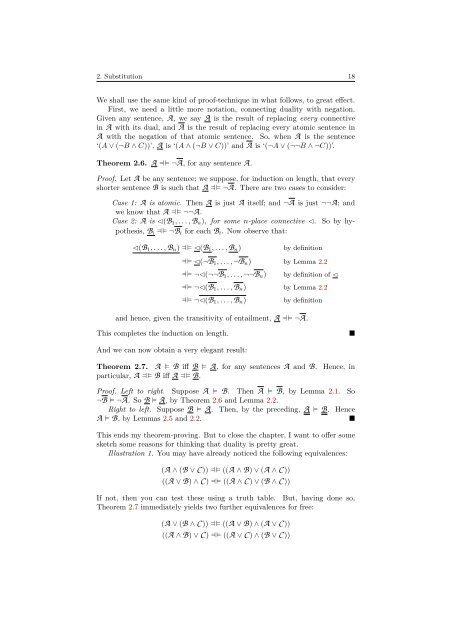Metatheory - University of Cambridge
Metatheory - University of Cambridge
Metatheory - University of Cambridge
You also want an ePaper? Increase the reach of your titles
YUMPU automatically turns print PDFs into web optimized ePapers that Google loves.
2. Substitution 18<br />
We shall use the same kind <strong>of</strong> pro<strong>of</strong>-technique in what follows, to great effect.<br />
First, we need a little more notation, connecting duality with negation.<br />
Given any sentence, A, we say A is the result <strong>of</strong> replacing every connective<br />
in A with its dual, and A is the result <strong>of</strong> replacing every atomic sentence in<br />
A with the negation <strong>of</strong> that atomic sentence. So, when A is the sentence<br />
‘(A ∨ (¬B ∧ C))’, A is ‘(A ∧ (¬B ∨ C))’ and A is ‘(¬A ∨ (¬¬B ∧ ¬C))’.<br />
Theorem 2.6. A<br />
⊨<br />
⊨ ¬A, for any sentence A.<br />
Pro<strong>of</strong>. Let A be any sentence; we suppose, for induction on length, that every<br />
shorter sentence B is such that A ⊨ ¬A. There are two cases to consider:<br />
⊨<br />
Case 1: A is atomic. Then A is just A itself; and ¬A is just ¬¬A; and<br />
we know that A ⊨ ¬¬A.<br />
Case 2: A is ◁(B 1 , . . . , B n ), for some n-place connective ◁. So by hypothesis,<br />
B i ⊨ ¬B i for each B i . Now observe that:<br />
⊨<br />
⊨<br />
◁(B 1 , . . . , B n )<br />
⊨<br />
⊨<br />
⊨<br />
⊨<br />
⊨<br />
⊨ ◁(B 1 , . . . , B n )<br />
by definition<br />
⊨ ◁(¬B 1 , . . . , ¬B n ) by Lemma 2.2<br />
⊨ ¬◁(¬¬B 1 , . . . , ¬¬B n ) by definition <strong>of</strong> ◁<br />
⊨ ¬◁(B 1 , . . . , B n ) by Lemma 2.2<br />
⊨ ¬◁(B 1 , . . . , B n )<br />
by definition<br />
and hence, given the transitivity <strong>of</strong> entailment, A<br />
This completes the induction on length.<br />
⊨<br />
⊨ ¬A.<br />
■<br />
And we can now obtain a very elegant result:<br />
Theorem 2.7. A ⊨ B iff B ⊨ A, for any sentences A and B. Hence, in<br />
particular, A ⊨ B iff A ⊨ B.<br />
⊨<br />
⊨<br />
Pro<strong>of</strong>. Left to right. Suppose A ⊨ B. Then A ⊨ B, by Lemma 2.1. So<br />
¬B ⊨ ¬A. So B ⊨ A, by Theorem 2.6 and Lemma 2.2.<br />
Right to left. Suppose B ⊨ A. Then, by the preceding, A ⊨ B. Hence<br />
A ⊨ B, by Lemmas 2.5 and 2.2.<br />
■<br />
This ends my theorem-proving. But to close the chapter, I want to <strong>of</strong>fer some<br />
sketch some reasons for thinking that duality is pretty great.<br />
Illustration 1. You may have already noticed the following equivalences:<br />
(A ∧ (B ∨ C ))<br />
((A ∨ B) ∧ C )<br />
⊨<br />
⊨<br />
⊨ ((A ∧ B) ∨ (A ∧ C ))<br />
⊨ ((A ∧ C ) ∨ (B ∧ C ))<br />
If not, then you can test these using a truth table. But, having done so,<br />
Theorem 2.7 immediately yields two further equivalences for free:<br />
(A ∨ (B ∧ C ))<br />
((A ∧ B) ∨ C )<br />
⊨<br />
⊨<br />
⊨ ((A ∨ B) ∧ (A ∨ C ))<br />
⊨ ((A ∨ C ) ∧ (B ∨ C ))
















